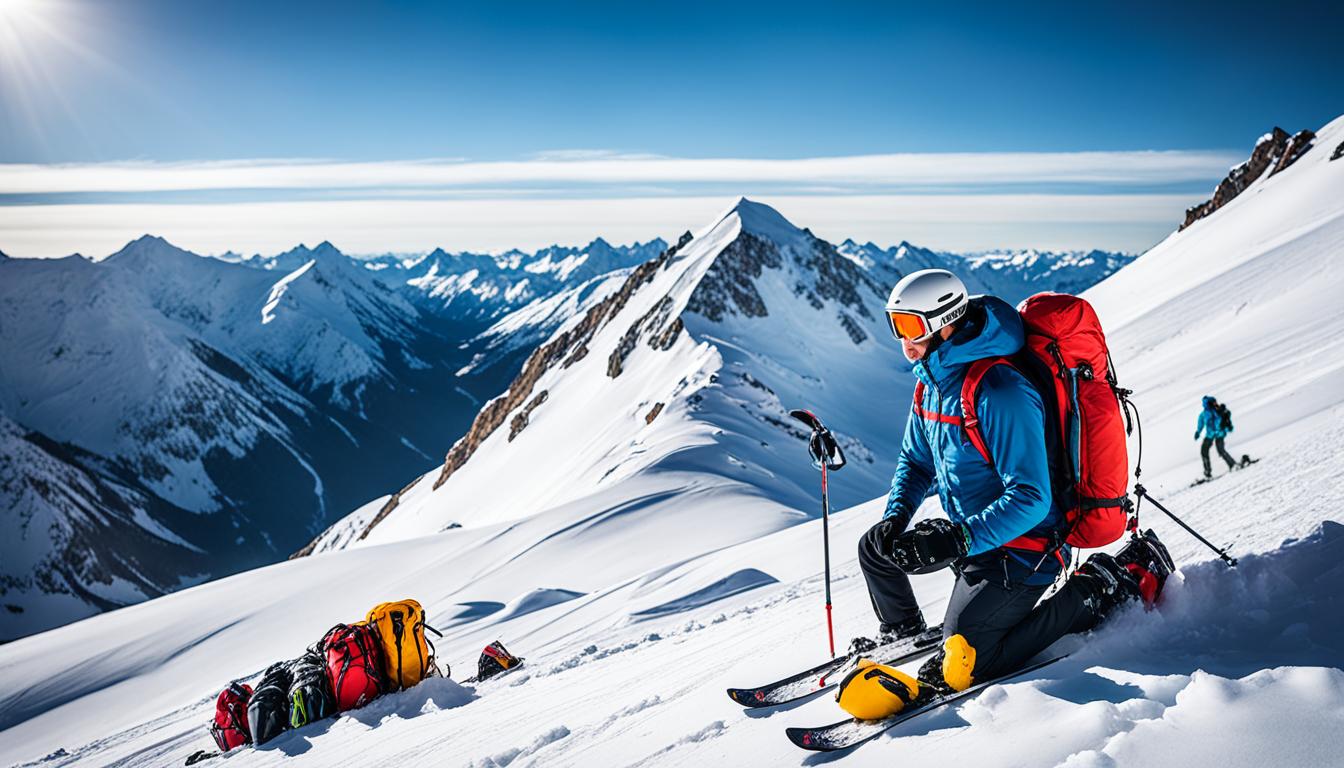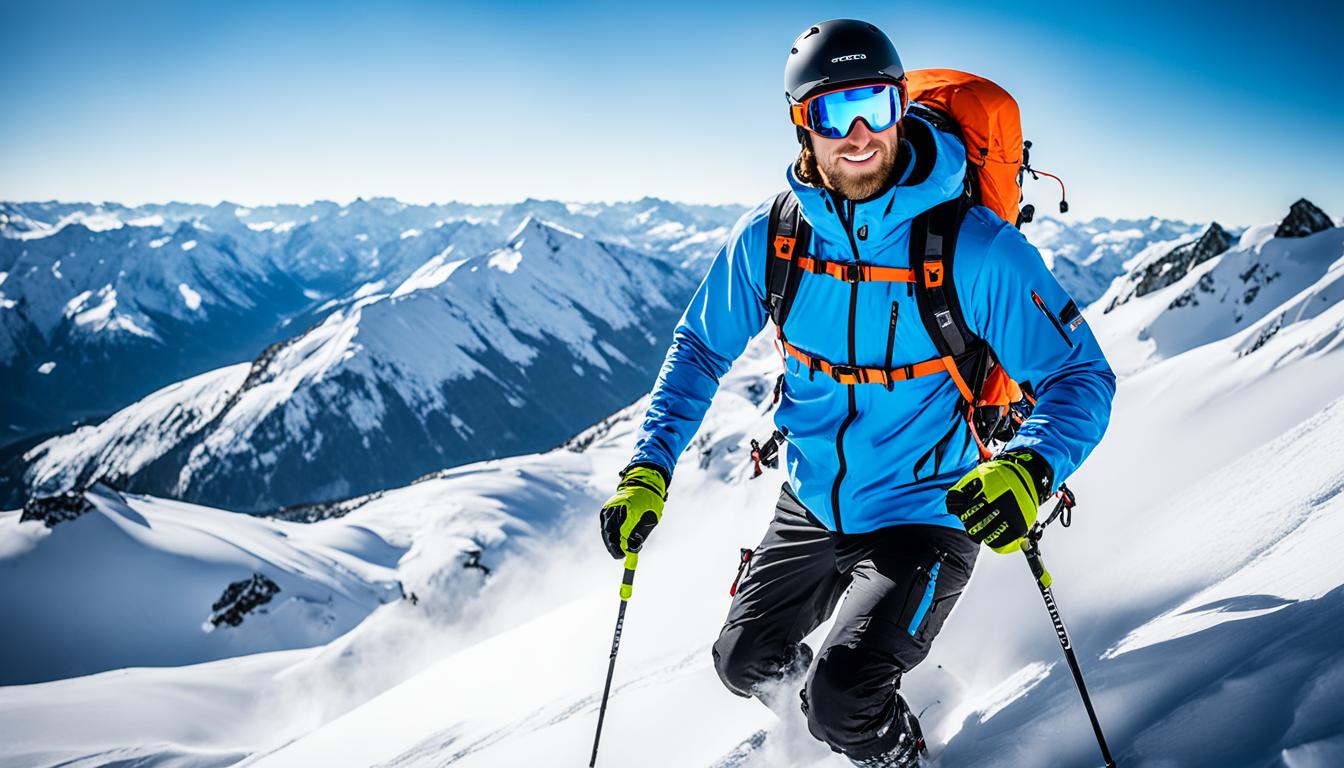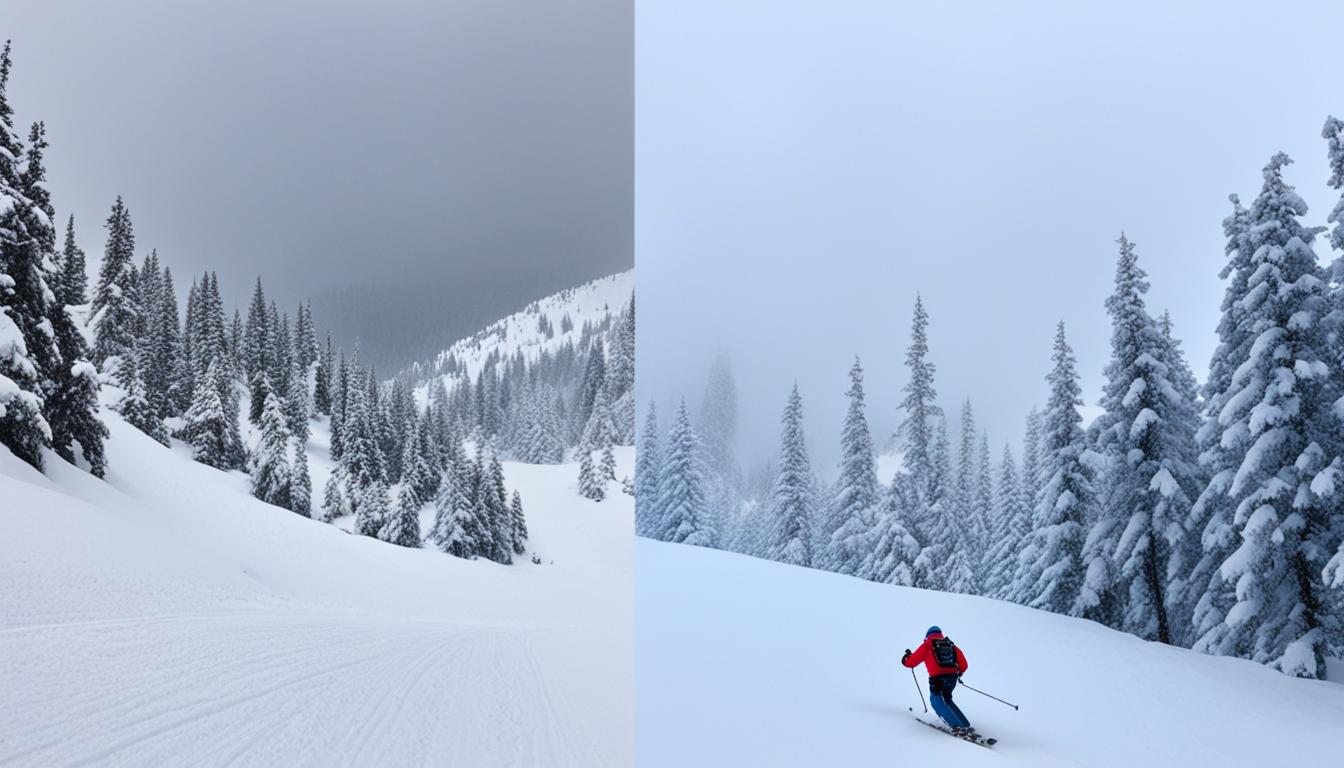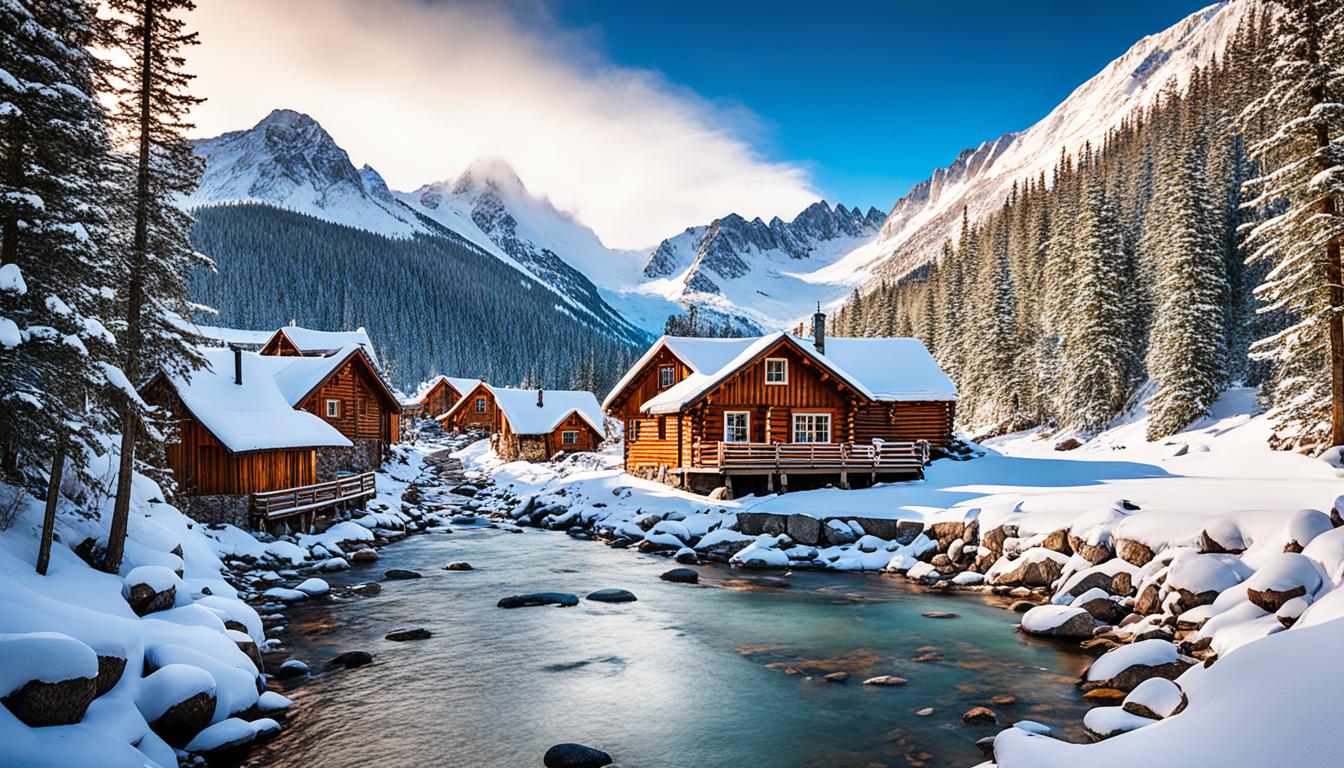Are you ready for a thrilling backcountry skiing trip? Before you go, make sure you have the right gear. It will keep you safe and make your adventure unforgettable. This checklist covers all you need for a great backcountry skiing journey.
Key Takeaways:
- Choose backcountry skis that fit your skills and the places you’ll ski.
- Quality touring boots will give you the comfort and control you need.
- Always carry avalanche safety gear – a beacon, shovel, and probe – to stay safe.
- Navigation tools like a compass and maps are essential to avoid getting lost.
- Dress in hardshell jackets, ski pants, baselayers, and warm accessories for all weather.
The right gear is vital for safety and to make your skiing fun. So, get your gear together. Then, head out to the snow-covered lands. You’ll have a blast exploring the winter wilderness!
Backcountry Ski Equipment
When you go into the backcountry for skiing, having the right gear is key. It keeps you safe and makes the trip fun. Let’s look at some important backcountry ski gear:
Backcountry Skis
These skis are made for exploring off the beaten path. They give you stability and control in all kinds of snow. Think about the weight, width, and how steady they are to match your skiing and the land you’ll cover.
Backcountry Ski Boots
Getting the best backcountry ski boots means you can ski better and more comfortably. Opt for boots that are strong but can also bend a bit. This helps you power through slopes and move easily uphill. Make sure the boots work with your ski bindings too.
Ski Bindings
Selecting the right ski bindings for backcountry adventures is critical. They have to keep you safe but also work well. Light, safe, and with smooth switches from touring to skiing are what you’re after. Think about release settings and brakes too, based on what you prefer and ski width.
Ski Poles
Ski poles that are strong yet not heavy will help you stay upright and move forward. Choose poles that can adjust, have comfy grips, and lock easily. Pick ones that fit your height and skiing method well.
Climbing Skins
Climbing skins are vital for going uphill in the backcountry. These sticky strips go on the skis’ undersides to help you climb. Pick skins that stick well, are simple to use, and slide smoothly.
The right backcountry ski equipment betters your time and safety out in the wild. Keep your gear in top shape by checking it often. Repair or replace worn-out items to stay ready. With good gear and preparation, you can take on the backcountry with confidence.
Avalanche Safety Gear
Staying safe in the backcountry is key. It’s important to have the right avalanche safety gear when going into areas prone to them. This gear helps reduce risks and deal with emergencies if they happen.
A beacon is a must-have. It’s also called an avalanche transceiver. This tool sends and receives signals. It helps find and rescue people buried by an avalanche. With a beacon, you can quickly find others and help rescue them.
A probe is also critical. It’s a long pole that can be adjusted in size. This tool helps find exactly where a person is buried. It tells rescue teams how deep the victim is under the snow. This makes the rescue process much faster.
Don’t forget a shovel. It’s essential for digging out those trapped by snow. Your shovel should be sturdy but not heavy. It needs to be easy to carry in your backpack. A good shovel makes digging through snow faster.
Navigation and Route Finding
Having a compass is important in the backcountry. It helps you know where you are going. Maps are also vital. They help you plan your route. This ensures you don’t get lost and stay on course.
First Aid and Repair Kits
Accidents and gear problems can occur. That’s why you should always carry a first aid kit and repair kit. A first aid kit needs bandages, wound cleaners, and pain medicine. A repair kit should have things like duct tape and spare parts for gear.
Always remember to have the correct safety gear and tools when heading out. Knowing how to use them is as important as carrying them. Regular practice prepares you to handle any surprises in the backcountry.
Backcountry Ski Clothing
Choosing the right clothes for backcountry skiing is key. You need the best gear to fight off the weather. This makes sure your trip is fun and not just cold.
Hardshell or Ski Jacket
Your jacket is like a shield against wind, snow, and water. It should keep you dry but still let your body breathe. This balance is critical for your comfort during skiing.
Ski Pants or Bibs
Don’t forget about your legs when choosing gear. Pick pants that are waterproof but also let moisture out. They should fit well to move freely while skiing.
Ski Gloves and Liners
Your hands need special care in the backcountry. Choose gloves that are warm, dry, and tough on the palms. Wear liners underneath for extra heat when it’s not too cold.
Baselayers
Start with baselayers to keep your skin dry and warm. These clothes draw sweat away from your body. They should be snug and made from materials that breathe well, like wool or some synthetics.
Midlayer
On cold days, you’ll want a good midlayer for warmth. Fleece or synthetic jackets do a great job. They keep you cozy by trapping warmth but are still breathable.
Down Jacket
For real cold snaps, a down jacket comes in handy. It should be light and can pack up small. This outer layer keeps you toasty when you’re not moving much.
Ski Socks
Remember, your feet need love, too. Get socks that pull moisture away and pad your feet. This combo keeps away blisters and ensures your feet stay dry and warm.
Hat
A warm hat is not to be underestimated. Find one that covers your ears and wicks moisture. It keeps your head warm, helping your whole body stay at the right temperature.
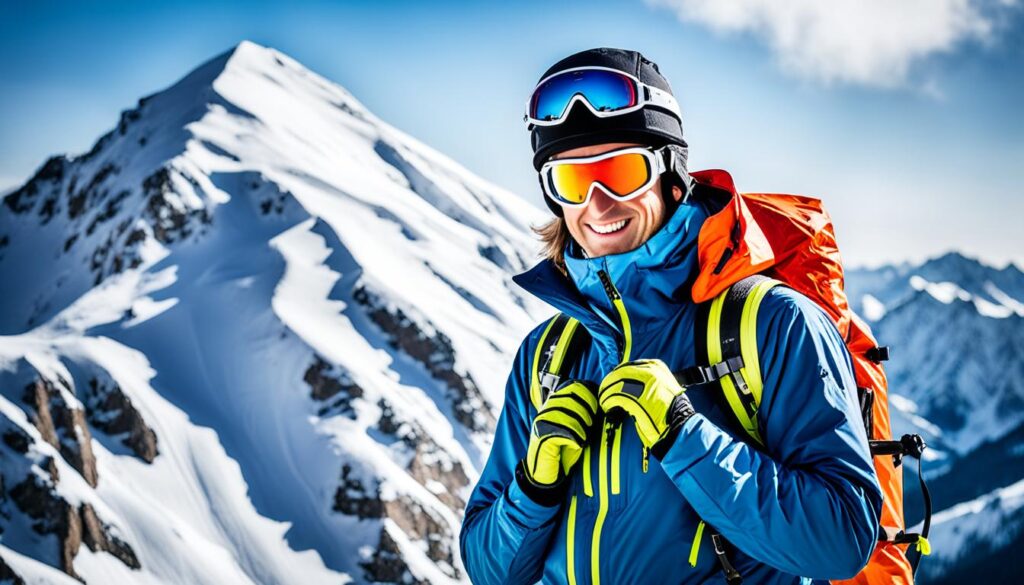
Additional Items
Along with the vital gear, a few extra items boost my comfort and safety in the wild. They make my backcountry skiing trips better overall.
Sunglasses or Goggles
Shielding my eyes from the sun and harmful UV rays is key. This is why I never go without my sunglasses or goggles. They not only protect me but also help see clearly in the snow or sun.
Ski Helmet
Safety comes first when I’m skiing downhill. A ski helmet is essential for protecting against falls. Make sure the helmet is a good fit and meets all safety standards.
Ski Backpack
A dependable ski backpack is essential for storing all vital gear. It carries extra clothes, snacks, and water. Find one that’s easy to carry and lets you grab items quickly.
Snacks and Water Bottles
It’s key to eat right and stay hydrated to keep going strong. I pack snacks like energy bars and water bottles. Enough water keeps you going during the adventure.
Camera
Don’t miss capturing the beautiful memories on your trip. Bring a camera or a waterproof action camera. This lets you save and share the moments with loved ones.
Communication Devices
Staying in touch during backcountry skiing is important in case of emergency. A two-way radio or satellite messenger is handy. It helps you call for help if needed.
Sunscreen and Lip Balm
Protecting your skin and lips from the harsh elements is vital. Use sunscreen and lip balm with SPF protection. This keeps your skin from burning and your lips from getting chapped.
Disposable Hand Warmers
Dropping temperatures call for quick hand warmers. These little packs of warmth can be game-changers. Keep a few in your backpack for when your hands get cold.
Adding these items to your backcountry skiing gear ensures a more comfortable and fun trip. Remember, safeguard yourself and pack smart for your adventure ahead.

Tips for Backcountry Skiing Safety
Along with the main gear, there are some safety items you should take. Think about adding ski crampons for better grip on ice. And also consider boot crampons and an ice axe for more challenging terrains.
Inclinometer and compass are critical for knowing the way and the steepness of slopes. They help keep you safe and choose the best paths.
Carrying a snow study kit can be lifesaving. With it, you can check snow stability and spot avalanche risks. This way, you make smarter choices during your trip.
It’s smart to pack an emergency shelter or blanket for unforeseen events. These can keep you warm and protected if you get stuck or need to wait for help.
A balaclava or neck gaiter protects your face from extreme weather. They prevent cold winds and temperatures from harming your skin, making your trip more comfortable.
Bringing a knife or multi-tool is also wise. They’re useful for fixing gear and managing any surprises that might come up.
Always prioritize safety
Backcountry skiing demands putting safety first. With proper gear, you lower the dangers and have a better, safer time.
“Backcountry skiing offers unique and rewarding experiences, but it’s important to be prepared. Carrying safety gear such as ski crampons, boot crampons, an ice axe, an inclinometer, compass, snow study kit, emergency shelter, a balaclava or neck gaiter, and a knife or multi-tool can greatly enhance your safety and peace of mind.”
Before you head out for your next backcountry skiing trip, check your gear thoroughly. Make sure you have all safety essentials. Being well-prepared is crucial for a great and safe adventure in the mountains.
Conclusion
To have a great time backcountry skiing, you need the right essential gear for backcountry skiing. It’s important to pick the best backcountry skis and touring boots. Also, make sure you have all the avalanche safety gear you need. Think about what you need and the places you’ll ski.
Buying good equipment is a big plus for your skiing trips. A dependable splitboard or ski touring poles are a must. Make sure to have a top-notch backcountry backpack to carry your stuff. Don’t forget items like a beacon, shovel, and probe for safety against avalanches.
No matter if you’re very experienced or just starting, having the correct gear is essential. It keeps you ready for any unexpected situation. Enjoy the beautiful outdoors safely and have a ton of fun skiing in the backcountry!
FAQ
What should I consider when choosing backcountry skis?
When picking backcountry skis, think about their weight, width, and how stable they are.
What kind of boots should I use for backcountry skiing?
Use backcountry boots that are comfy and react well when you’re out on the snow.
What type of bindings should I use for backcountry skiing?
Choose bindings that match your skis for the best performance in the backcountry.
Are ski poles necessary for backcountry skiing?
Durable ski poles help with balance and moving forward when skiing off the beaten path.
What are climbing skins used for in backcountry skiing?
Climbing skins prevent you from sliding downhill as you climb up steep snowy slopes.
What avalanche safety gear do I need for backcountry skiing?
Essential avalanche safety items are a beacon, probe, and a shovel.
Why do I need navigation tools for backcountry skiing?
Tools like a compass and maps are vital for finding your way in the backcountry.
Should I carry a first aid kit in the backcountry?
It’s critical to have a first aid kit to deal with unexpected accidents when skiing in remote areas.
What should I wear for backcountry skiing?
Wear layers including a hardshell or ski jacket, ski pants, baselayers, and midlayers. Also, remember a hat and gloves for warmth.
Are there any additional items I should bring for backcountry skiing?
Bring sunglasses or goggles, a helmet, snacks, water, a camera, communication devices, and sunscreen. Also, pack lip balm and hand warmers.
What additional safety items and tools can enhance my backcountry skiing experience?
For better safety, bring ski crampons, boot crampons, an ice axe, and an inclinometer. Also consider a compass, snow study kit, emergency shelter, and a multi-tool.
How can I ensure a safe and fulfilling backcountry skiing experience?
To enjoy backcountry skiing safely, have the right gear, prepare well, and put safety first in everything you do.

